
The Eleazer Arnold House is a historic house built for Eleazer Arnold in about 1693, and located in the Great Road Historic District at Lincoln, Rhode Island. It is now a National Historic Landmark owned by Historic New England, and open to the public on weekends.
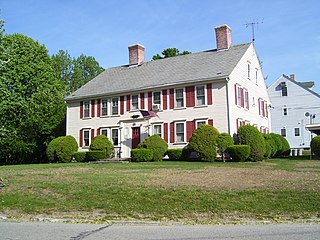
The Peleg Arnold Tavern off Great Road in Union Village in North Smithfield, Rhode Island was built around 1690 and is one of the oldest homes in North Smithfield. The oldest part of house was built in the late 17th century by Richard Arnold, one of the earliest settlers in the area. His descendant, Peleg Arnold, greatly expanded the building a century later. Peleg Arnold was a justice of the Rhode Island Supreme Court and representative to the Continental Congress. Arnold's popular tavern served as center of American military operations in the town during the American Revolution. The house was added to the National Register of Historic Places in 1974.

The Israel Arnold House is an historic house on Great Road in Lincoln, Rhode Island. It is a 2+1⁄2-story wood-frame structure, set on a hillside lot on the south side of Great Road. The main block is five bays wide, with a central chimney rising through the gable roof. A 1+1⁄2-story gambrel-roofed ell extends to one side. The ell is the oldest portion of the house, built c. 1720 by someone named Olney. The main block was built c. 1760. The house was owned into the 20th century by four generations of individuals named Israel Arnold.

The Samuel B. Conant House is an historic house in Central Falls, Rhode Island. This 2+1⁄2-story structure was built in 1895 for Samuel Conant, president of a Pawtucket printing firm, and is one of the city's finest Colonial Revival houses. Its exterior is brick on the first floor and clapboard above, beneath a gambrel roof punctured by several gable dormers. The main facade has two symmetrical round bays, which rise to the roof and are topped by low balustrades. A single-story porch extends between the center points of these bays, and is also topped by a low balustrade.

The James Dennis House is an historic house located at 3120 Pawtucket Avenue in East Providence, Rhode Island. This two-story wood-frame house was built sometime in the 1870s, and is a fine local example of Queen Anne Victorian style. Its most prominent features are a square tower with pyramidal roof, and a decorated porch that wraps around three sides. Although Pawtucket Avenue once had a significant number of such houses lining it, most have been demolished or significantly altered.
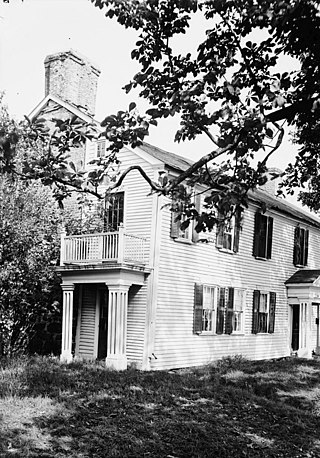
The Joseph Smith House is a historic house at 109 Smithfield Road in North Providence, Rhode Island, United States. It is a 2½-story wood-frame house, six bays wide, with a shed-style addition to the rear giving it a saltbox appearance. The oldest portion of this house, built around 1705, is a classical Rhode Island stone-ender house, whose large chimney has since been completely enclosed in the structure. The lower levels of this chimney are believed to predate King Philip's War (1675–76), when the previous house was burned. The 1705 house was built by Joseph Smith, grandson of John Smith, the miller, one of Rhode Island's first settlers. It was greatly enlarged in 1762 by Daniel Jenckes, a judge from a prominent Rhode Island family, for his son, and was for many years in the hands of Jenckes' descendants. The house is the only known surviving stone-ender in North Providence.
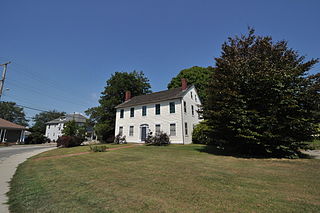
The Whitcomb Farm is an historic farmhouse in East Providence, Rhode Island. The 2+1⁄2-story structure was built c. 1780–1805, and is a well-preserved example of Federal architecture. Its construction is unusual, consisting of a brick structure finished with wood clapboards. The house has been owned by a number of prominent local citizens, including William Whitcomb, the proprietor the City Hotel in Providence.

The Woods–Gerry House is an historic house on 62 Prospect Street in Providence, Rhode Island, United States. It is a large, three story brick structure, designed by Richard Upjohn and built in 1860 for Dr. and Mrs. Marshall Wood. It is the largest surviving 19th-century house in Providence, measuring 55 feet (17 m) in width and 75 feet (23 m) in depth. It features restrained Italianate styling, most evident in its porch and porte-cochere, and in its roofline. The building currently houses the Admissions office for the Rhode Island School of Design.

Dominic Hall, also known as St. Dominic House and the William L. Bailey House, is a historic house on the Providence College campus in Providence, Rhode Island. It is a 2+1⁄2-story stone-faced structure with timber framing, and a prominent octagonal four-story tower at its southeastern corner. The house was built in the 1850s by William Bailey, who had a 23-acre (9.3 ha) estate. In the early 20th century the estate was acquired by the local Dominican Order, which used it as a convent and girls' school. The property was then absorbed by Providence College.

The Corliss–Brackett House, also known as the Charles Brackett House, is an historic house in the College Hill neighborhood of Providence, Rhode Island. The house is located at 45 Prospect Street at the southeast corner of Prospect and Angell Streets. According to Richard B. Harrington of the Rhode Island State Historical Preservation Commission, "There remain anywhere very few very formally and more monumentally treated durable masonry examples of the 'Italian (Tuscan) Villa style.'"

The Covell Street School is an historic school building at 231 Amherst Street in Providence, Rhode Island. It is a two-story wood-frame structure built in a typically elaborate Queen Anne style. Although it is basically rectangular in plan, its roofline and exterior are busy, with a complicated group of cross gables, hip-roof sections, with projecting and recessed sections. A three-story square tower rises from the center of the main facade. Built in 1885 and opened in 1886, it is one of Providence's last surviving 19th-century neighborhood school buildings. It was designed by the local firm of William R. Walker & Son, designers of many Rhode Island civic buildings. The builders were John L. Sprague & Company.
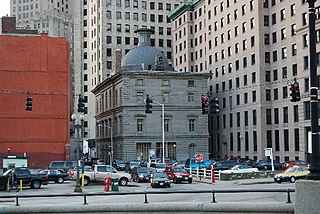
The Customhouse Historic District is a historic district encompassing fifteen historic buildings in downtown Providence, Rhode Island. The district is bounded by Westminster, Exchange, Dyer, Pine, and Peck Streets, and includes eight buildings associated with the important functions of the business center Providence became in the mid-to-late 19th century. It was listed on the National Register of Historic Places in 1975, and is completely contained within the Downtown Providence Historic District, listed in 1984.

The Ernest Street Sewage Pumping Station is an historic wastewater pumping station at Ernest and Ellis Streets near the wastewater treatment facility at Field's Point in Providence, Rhode Island. The surviving elements of the station include a main pumphouse and a smaller screening house, both built in 1897-98 as part of a major effort to modernize Providence's sewage treatment facilities. A third structure, a boiler house, was demolished in 1987, and a tall smokestack was taken down in the 1930s.

The First Universalist Church is a historic church at 250 Washington Street in Providence, Rhode Island.

The Joseph Haile House is an historic house in the College Hill neighborhood of Providence, Rhode Island. It is a 3+1⁄2-story brick structure, appearing taller than that due to its hillside location and raised basement. It is a well-preserved example of Federal styling, which underwent a careful restoration in the 1930s by George Warren Gardner, who filled the house with early American furniture. The Gardners bequested the property to Brown University, which uses it to house visiting dignitaries.

The Market House is a historic three-story brick market house in Market Square, in the College Hill, a neighborhood of Providence, Rhode Island, USA. The building was constructed between 1773 and 1775 and designed by prominent local architects, Joseph Brown and Declaration of Independence signer Stephen Hopkins. The bottom floor of the house was used as a market, and the upper level was used for holding meetings. Similar buildings existed in other American cities, such as Faneuil Hall in Boston and the Old Brick Market in Newport. The building housed the Providence City Council in the decades before the completion of City Hall.

The Rhode Island Hospital Trust Building is an historic commercial building in downtown Providence, Rhode Island, United States, designed by York & Sawyer.

The Sludge Press House was an historic wastewater treatment facility building at the Fields Point Sewage Treatment Plant at Fields Point, Rhode Island in Providence, Rhode Island. It was a two-story brick structure, located near the center of the Field's Point facility, just east of the Chemical Building. It was about 138 by 51 feet in size, with a hip roof, and was built 1899-1901 as part of Providence's first wastewater treatment system. It housed the facilities used at the end of the treatment process by which remaining solids were dewatered and compressed before final disposal.
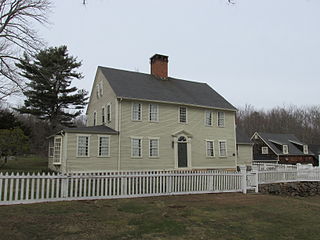
The Wilson–Winslow House is a historic house in Coventry, Rhode Island. The main block of this 2+1⁄2-story wood-frame house was built in 1814 by Joseph Wilson, a farmer. It was occupied for most of the nineteenth century by his son, Israel Wilson, and it remained in the family's ownership until 1917. Architectural historian William Jordy noted that it was "very grand" for its rural location.

The Susan S. and Edward J. Cutler House is a historic house in Providence, Rhode Island. It is an L-shaped 1+1⁄2-story wood-frame structure, with a gabled roof and a single-story porch and vestibule in the crook of the L. The front facade has a rectangular projecting bay, with panels below the windows, and a bracketed hip roof. The front and side gables both feature Stick style decorative woodwork. The entry porch roof is bracketed, matching the front bay, and has a jigsawn balustrade. The interior features late Victorian woodwork, plasterwork and original hardware. The house was built in 1880, probably from plans in a published pattern book, and was the first to be built in a relatively new subdivision on Providence's north side. It is a well-preserved example of a "picturesque cottage", a style popularized by a number of 19th-century architects.






















